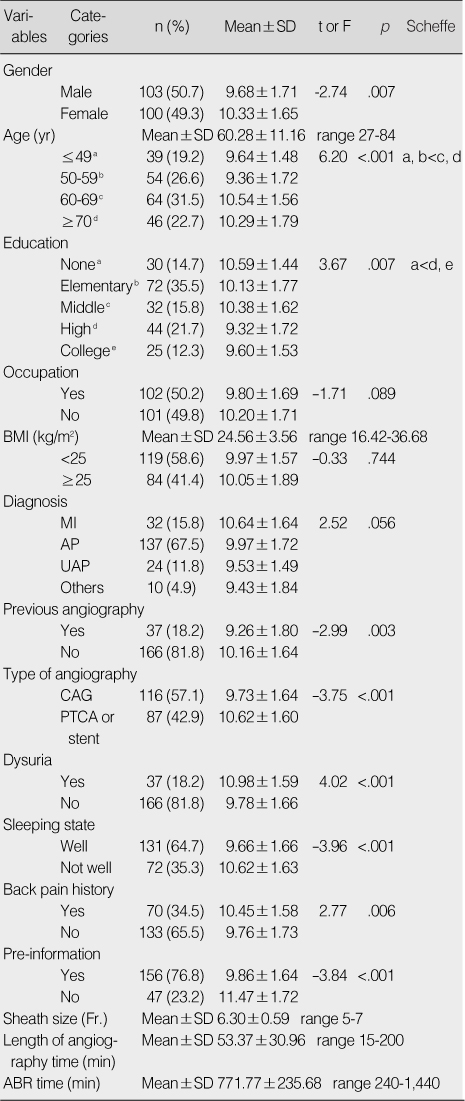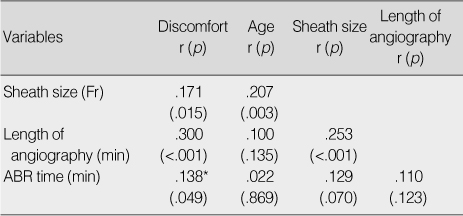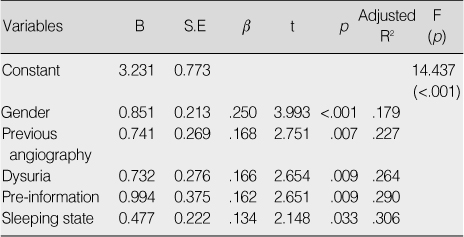Articles
- Page Path
- HOME > J Korean Acad Nurs > Volume 39(6); 2009 > Article
-
Original Article
- Factors Predicting Patient Discomfort after Coronary Angiography
- Ae Ran Park, Ja Yun Choi
-
Journal of Korean Academy of Nursing 2009;39(6):860-867.
DOI: https://doi.org/10.4040/jkan.2009.39.6.860
Published online: December 31, 2009
1Head Nurse, St. Garollo Hospital, Suncheon, Korea.
2Associate Professor, College of Nursing, Chonnam National University · Chonnam Research Institute of Nursing Science, Gwangju, Korea.
- Address reprint requests to: Choi, Ja Yun. College of Nursing, Chonnam National University, 5 Hak-dong, Dong-gu, Gwangju 501-190, Korea. Tel: 82-62-220-4343, Fax: 82-62-225-3307, Choijy@jnu.ac.kr
Copyright © 2009 Korean Society of Nursing Science
Abstract
-
Purpose
- The purpose of this study was to identify the factors that predict discomfort after coronary angiography or percutaneous coronary intervention (PCI) among hospitalized patients.
-
Methods
- A total of 203 patients who underwent coronary angiography or PCI were recruited from C hospital located in S city, J province, from June through August 2008. The level of discomfort was measured and standardized by two instruments, discomfort questionnaire and the Visual Analogue Scale (VAS).
-
Results
- Stepwise multiple regression showed that the factors predicting the level of discomfort were type of angiography, gender, previous angiography, dysuria, pre-information, and sleep satisfaction, which together explained 30.6% of the total variance of the level of discomfort.
-
Conclusion
- Patients who had previous experience with these procedures, received a pre-information about the upcoming procedure, had no dysuria, and had slept well after the procedure were less likely to complain discomfort. Pre-informed education should be given by nurses to patients who will have an angiography or PCI to reduce their physical and emotional discomforts.
This article is based on a part of the first author's master's thesis from Chonnam National University.
This study was financially supported by Chonnam Research Institute of Nursing Science.
- 1. Chair SY, Taylor-Piliae RE, Lam G, Chan S. Effect of positioning on back pain after coronary angiography. Journal of Advanced Nursing. 2003;42:470–478.ArticlePubMedPDF
- 2. Chlan LL, Sabo J, Savik K. Effects of three groin compression methods on patient discomfort, distress, and vascular complications following a percutaneous coronary intervention procedure. Nursing Research. 2005;54:391–398.ArticlePubMed
- 3. Cho MH, Lee KJ. A study of perceived discomfort of intensive care unit patient. Journal of Korean Academy of Adult Nursing. 1992;4:209–223.
- 4. Hayman LL, Reineke PR. Preventing coronary heart disease: The implementation of healthy lifestyle strategies for children and adolescents. The Journal of Cardiovascular Nursing. 2003;18:294–301.ArticlePubMed
- 5. Jeong KI, Choi SH. The effect of an information using computer program on the reduction of anxiety in coronary angiogram subjects. The Journal of Korean Academic Society of Nursing Education. 2003;9:115–125.
- 6. Kasper DL, Braunwald E, Fauci AS, Hauser SL, Longo DL, Jameson JL. Harrison's principles of internal medicine. 2006;16th ed.New York, NY, McGraw-Hill.
- 7. Kee EJ. A study for discomfort and bleeding complications during absolute bed rest in patients undergoing percutaneous coronary intervention. 2001;Suwon, Ajou University. Unpublished master's thesis.
- 8. Keeling AW, Fisher CA, Haugh KH, Powers ER, Turner MS. Reducing time in bed after percutaneous transluminal coronary angioplasty (TIBS III). American Journal of Critical Care. 2000;9:185–187.PubMed
- 9. Kim HS, Lee MH, Kim SY. Factors influencing on quality of sleeping among patients at surgical intensive care units. Journal of Korean Academy of Adult Nursing. 2008;20:365–374.
- 10. Kim MH, Han MJ, Lee JE, Lee JM. Effects of exercise and ice pack therapy on discomfort after percutaneous coronary intervention. Clinical Nursing Research. 2007;13:185–196.
- 11. Kim SJ. The effects of provided structured information of self-care knowledge and self-care behavior in patients underwent coronary intervention. 2006;Daegu, Catholic University of Daegu. Unpublished master's thesis.
- 12. Kim YH, Koo MJ, Kim SH, Kim YM, Lee NY, Chang KO. The experiences of patients in intensive care units (ICU). Journal of Korean Academy of Nursing. 2007;37:924–931.PubMed
- 13. Kim YJ, Chung SH, Suh IS. The effect of hand massage on discomfort in patients following percutaneous coronary intervention. Journal of Korean Academy of Adult Nursing. 2008;20:452–460.
- 14. Koo YJ, Koh HJ. Effects of eye protective device application on sleeping disorder with coronary disease patients in CCU. Journal of Korean Academy of Nursing. 2008;38:582–592.PubMed
- 15. 2006 annual report of major cause of death. Korea National Statistical Office data. 2007;Retrieved February 23, 2009. from http://www.kosis.kr.
- 16. Lee EJ. A study on perceived discomfort in patients following cardiac catheterization. Journal of Korean Academy of Nursing. 1995;25:124–140.
- 17. Lee EJ. A study on the effect of massage and exercise on discomfort in patients following cardiac catheterization. Journal of Korean Academy of Nursing Administration. 1997;3(2):81–94.
- 18. Nam SY. The effects of Fowler's position change on back pain and discomfort of the patients undergone percutaneous coronary interventions. 2007;Seoul, Seoul National University. Unnpublished master's thesis.
- 19. Park DI, Kim HJ, Park JH, Cho YK, Sohn CI, Jeon WK, et al. Factors affecting abdominal pain during colonoscopy. European Journal of Gastroenterology & Hepatology. 2007;19:695–699.
- 20. Park JS, Kim ES, Park CJ. The effects of the slow stroke back massage on discomfort in patients following percutaneous transluminal coronary angioplasty. Clinical Nursing Research. 2004;9(2):56–67.
- 21. Pollard SD, Munks K, Wales C, Crossman DC, Cumberland DC, Oakley GD, et al. Position and Mobilization Post-Angiography Study (PAMPAS): A comparison of 45 hours and 2.5 hours bed rest. Heart. 2003;89:447–448.PubMedPMC
- 22. Reynolds S, Waterhouse K, Milller KH. Patient care after percutaneous transluminal coronary angioplasty. Nursing Management. 2001;32(9):51–54.
- 23. Rossi ML, Zavalloni D, Scatturin M, Gasparini GL, Lisignoli V, Presbitero P. Immediate removal of femoralsheath following protamine administration in patients undergoing intracoronary paclitaxel-eluting-stent implantation. Expert Opinion on Phamocotherapy. 2007;8:2017–2024.
- 24. Shin SJ. A study on the gender difference of health status on the recovery state after CABG (coronary artery bypass grafting). Journal of Nursing Science. 2003;15:1–8.
- 25. Tengiz I, Ercan E, Bozdemir H, Durmaz O, Gungun C, Nalbantgil I. Six hour ambulation after elective coronary angioplasty and stenting with 7F guiding catheters and low dose heparin. Kardilogia Polska. 2003;58:93–97.
- 26. Yilmaz E, Gurgun C, Dramali A. Minimizing short-term complications in patients who have undergone cardiac invasive procedure: A randomized controlled trial involving positionchange and sandbag. The Anatolian Journal of Cardiology. 2007;7:390–396.PubMed
- 27. Zalc S, Lemons PA, Esteves A, Ribeiro EE, Horta P, Nicolau JC, et al. Early ambulation and variability in anticoagulation during elective coronary stenting with a single intravenous bolus of low-dose, low-molecular weight heparin enoxaparin. The Journal of Invasive Cardiology. 2006;l18(2):45–48.
REFERENCES
Figure & Data
REFERENCES
Citations

- Effects of multimedia‐based information on anxiety, discomfort and satisfaction with care among patients undergoing cerebral angiography: A quasi‐experimental study
Hyunjung Choi, Jiyoung Kim
Journal of Clinical Nursing.2022; 31(7-8): 949. CrossRef - Effects of Aromatherapy on Stress Responses, Autonomic Nervous System Activity and Blood Pressure in the Patients Undergoing Coronary Angiography: A Non-Randomized Controlled Trial
Eun Jeong Song, Mi Young Lee
Journal of Korean Academy of Nursing.2018; 48(1): 1. CrossRef - Discomfort Reported by Patients After Cardiac Catheterization Using the Femoral or Radial Approaches
Caroline Dal Piva, Eliane Vaz, Maria Antonieta Moraes, Silvia Goldmeyer, Graciele Fernanda da Costa Linch, Emiliane Nogueira de Souza
Revista Brasileira de Cardiologia Invasiva (English Edition).2014; 22(1): 36. CrossRef
Level of Discomfort according to Discontinuous Variables (N=203)
BMI=body mass index; MI=myocardiac infarction; AP=angina pectoris; UAP=unstable angina pectoris; CAG=coronary angiography; PTCA= percutaneous coronary angioplasty; ABR=absolute bed rest.
Correlation of Discomfort with Continuous Variables (N=203)
ABR=absolute bed rest.
Factors Predicting Discomfort after Coronary Angiography (N=203)
BMI=body mass index; MI=myocardiac infarction; AP=angina pectoris; UAP=unstable angina pectoris; CAG=coronary angiography; PTCA= percutaneous coronary angioplasty; ABR=absolute bed rest.
ABR=absolute bed rest.
 KSNS
KSNS
 E-SUBMISSION
E-SUBMISSION



 Cite
Cite

